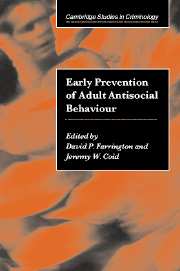Book contents
- Frontmatter
- Contents
- List of figures
- List of tables
- List of contributors
- Preface
- 1 Advancing knowledge about the early prevention of adult antisocial behaviour
- 2 Formulating strategies for the primary prevention of adult antisocial behaviour: “High risk” or ‘population’ strategies?
- 3 Risk factors for adult antisocial personality
- 4 Preventing the intergenerational continuity of antisocial behaviour: Implications of partner violence
- 5 Protective factors and resilience
- 6 Prevention during pregnancy, infancy and the preschool years
- 7 Prevention through family and parenting programmes
- 8 Prevention in the school years
- 9 Prevention of antisocial behaviour in females
- 10 Economic costs and benefits of primary prevention of delinquency and later offending: A review of the research
- 11 Conclusions and the way forward
- Index
- References
9 - Prevention of antisocial behaviour in females
Published online by Cambridge University Press: 22 September 2009
- Frontmatter
- Contents
- List of figures
- List of tables
- List of contributors
- Preface
- 1 Advancing knowledge about the early prevention of adult antisocial behaviour
- 2 Formulating strategies for the primary prevention of adult antisocial behaviour: “High risk” or ‘population’ strategies?
- 3 Risk factors for adult antisocial personality
- 4 Preventing the intergenerational continuity of antisocial behaviour: Implications of partner violence
- 5 Protective factors and resilience
- 6 Prevention during pregnancy, infancy and the preschool years
- 7 Prevention through family and parenting programmes
- 8 Prevention in the school years
- 9 Prevention of antisocial behaviour in females
- 10 Economic costs and benefits of primary prevention of delinquency and later offending: A review of the research
- 11 Conclusions and the way forward
- Index
- References
Summary
Sound preventive interventions to target antisocial behaviour among girls depends on reliable empirical data to address three primary questions. First, what are the rates and patterns of involvement in antisocial behaviour among females? Second, what are the predictors and correlates of involvement in antisocial behaviour among females? Third, is there any evidence of programme impact of interventions for females and is there any evidence of differential impact due to gender? In this chapter, I review the available empirical literature to summarise the state of our knowledge to address these questions to guide prevention efforts.
However, it is clear that the ability of the review to be informative for guiding prevention is constrained because there are limited data available that focus specifically on girls. Also, there are several issues that limit the ability to interpret much of the data that do exist. Therefore, the first part of the chapter focuses on three major issues that have constrained the state of knowledge regarding antisocial behaviour and girls: (1) lack of inclusion of girls in studies of antisocial behaviour, (2) differences in the behaviours that might define antisocial behaviour among girls and the long-term outcomes associated with antisocial behaviour in childhood for women and (3) the inclusion of gender in theory development. The second part of the chapter proposes an approach that can overcome these limitations and through which the development of antisocial behaviour for both males and females might be understood.
- Type
- Chapter
- Information
- Early Prevention of Adult Antisocial Behaviour , pp. 292 - 317Publisher: Cambridge University PressPrint publication year: 2003
References
- 10
- Cited by

